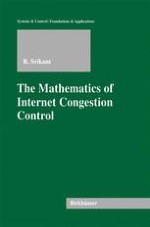2004 | OriginalPaper | Buchkapitel
Linear Analysis with Delay: The network case
verfasst von : R. Srikant
Erschienen in: The Mathematics of Internet Congestion Control
Verlag: Birkhäuser Boston
Enthalten in: Professional Book Archive
Aktivieren Sie unsere intelligente Suche, um passende Fachinhalte oder Patente zu finden.
Wählen Sie Textabschnitte aus um mit Künstlicher Intelligenz passenden Patente zu finden. powered by
Markieren Sie Textabschnitte, um KI-gestützt weitere passende Inhalte zu finden. powered by
In this chapter, we extend the delay analysis of Chapter 5 to the case of a network. As in Chapter 5, we linearize the system around its equilibrium point and derive conditions for local stability. We consider three main classes of controllers: 1.We consider different variants of the primal controllers introduced in Chapter 3 with delays in both the forward and backward paths. We also consider the AVQ algorithm to achieve full utilization.2.Next, we consider the dual controllers introduced in Chapter 3. Unlike the case with no delays, when delays are introduced into the network, we will see that, to ensure the stability of the dual controllers, only a certain class of source utility functions is allowed. However, borrowing the key idea from AVQ, we will see that a parameter in each source’s utility function can be dynamically chosen so that the network equilibrium can be interpreted as maximizing the sum of arbitrary source utilities. Another difference between the dual and primal controllers is that the congestion feedback in the dual algorithm is the delay in the network, whereas in the primal algorithm, the congestion feedback is in the form of packet marks or losses.3.Finally, we will consider primal-dual algorithms which allow one to model today’s Internet, by allowing the source control algorithms to be like TCP- Reno while the congestion feedback is closely related to the RED algorithm.
